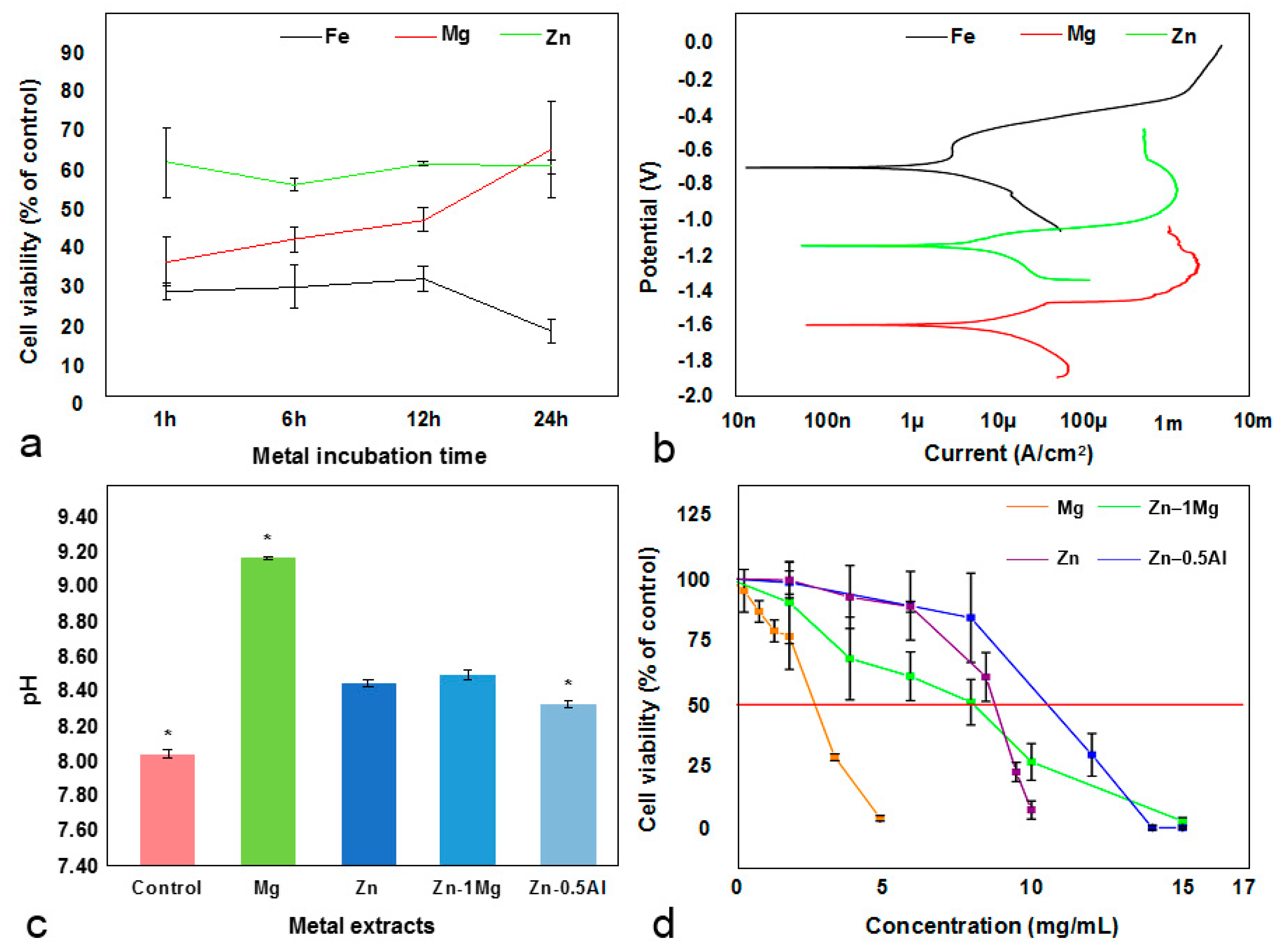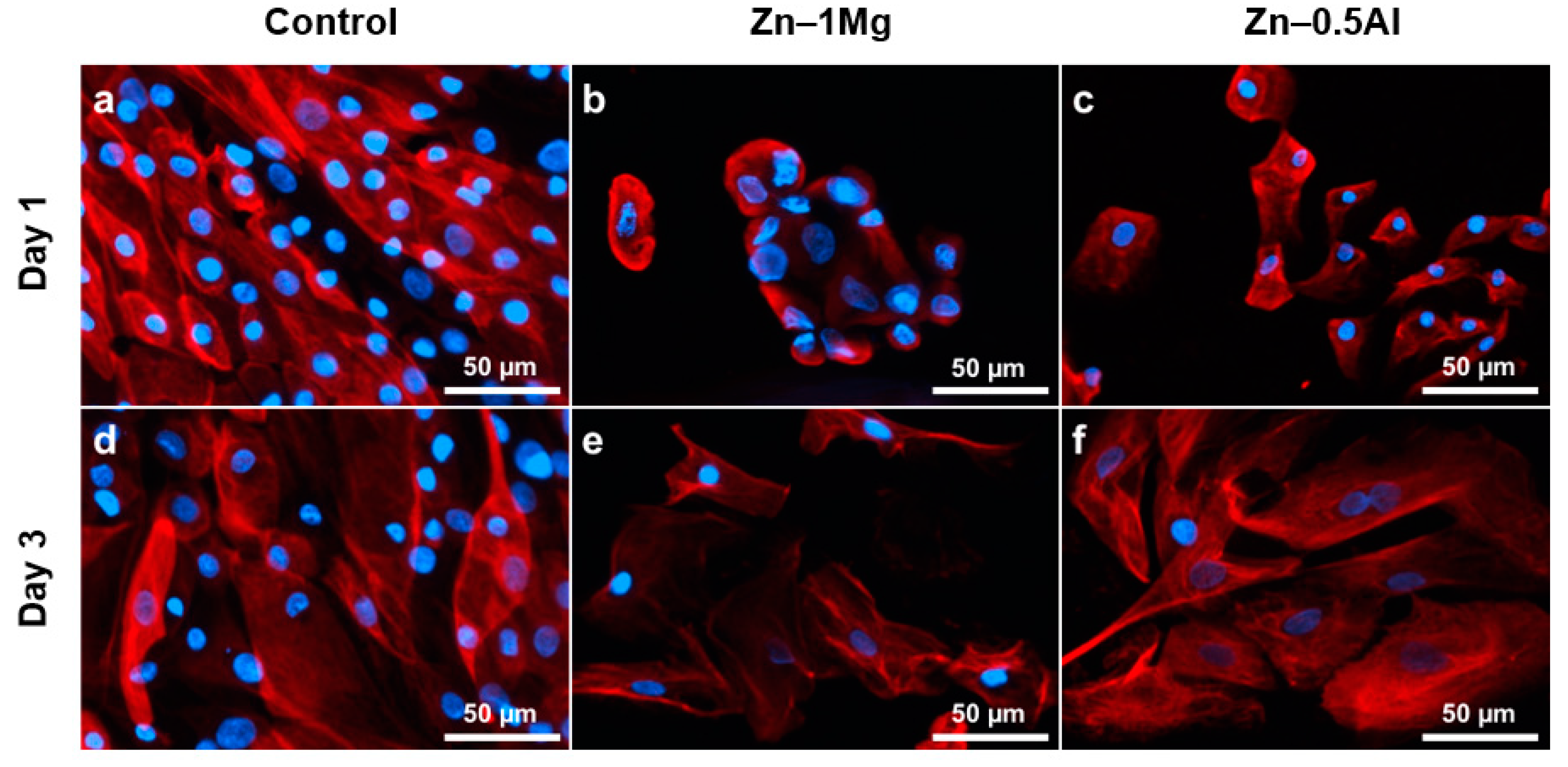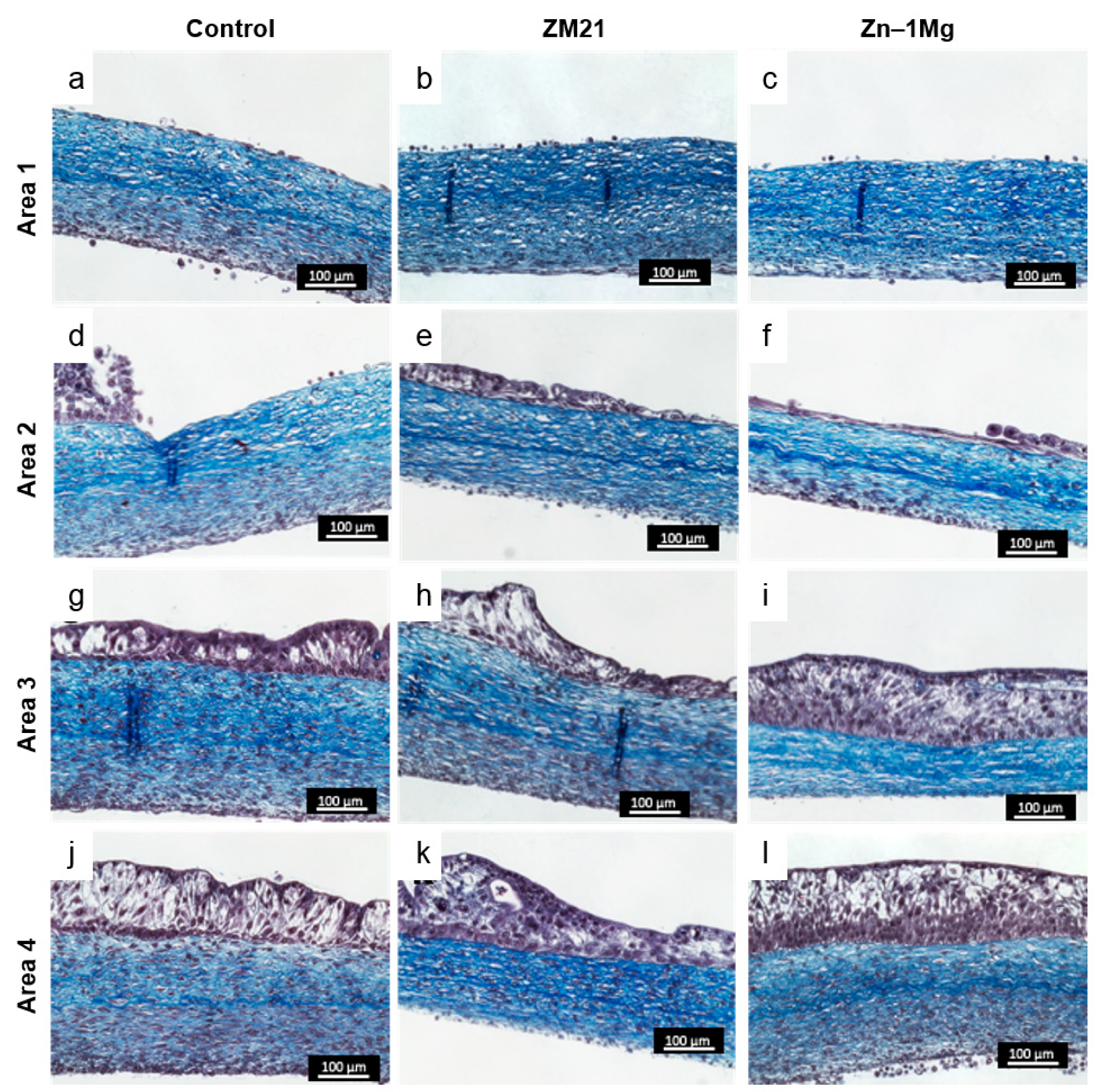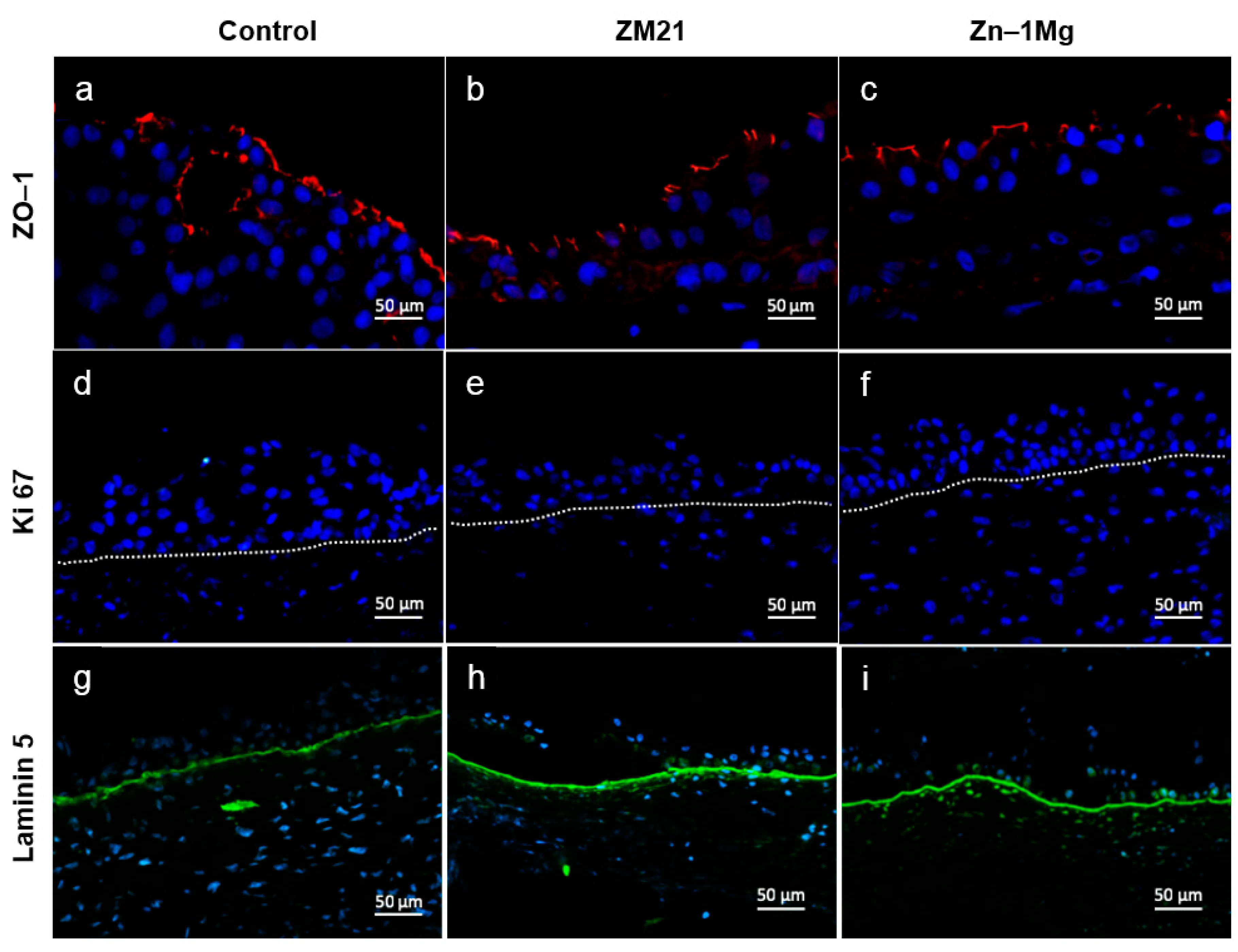Biological Assessment of Zn–Based Absorbable Metals for Ureteral Stent Applications
Abstract
:1. Introduction
2. Materials and Methods
2.1. Materials and Specimen Preparation
2.2. pH and Ion Measurement
2.3. Cell Extraction and Culture
2.4. Cell Viability Measurement in NHUC Monolayer Culture
2.5. Immunofluorescence for Cytoskeletal Observation
2.6. Flat 3D Ureteral Wall Model Preparation
2.7. 3D Cell Function Evaluation
2.8. Scanning Electron Microscopy
2.9. Statistical Analysis
3. Results and Discussion
3.1. Screening Tests
3.2. Cytoskeletal Observation
3.3. Cell Function Evaluation
3.4. Scanning Electron Microscopy Analysis
4. Conclusions
Author Contributions
Funding
Acknowledgments
Conflicts of Interest
References
- Frazier, M.S. Essentials of Human Diseases and Conditions, 3rd ed.; Elsevier Saunders: St. Louis, MO, USA, 2004; ISBN 9780323228367. [Google Scholar]
- Becker, A.; Baum, M. Obstructive uropathy. Early Hum. Dev. 2006, 82, 15–22. [Google Scholar] [CrossRef] [PubMed]
- Dyer, R.B.; Chen, M.Y.; Zagoria, R.J.; Regan, J.D.; Hood, C.G.; Kavanagh, P.V. Complications of Ureteral Stent Placement. Radiographics 2002, 22, 1005–1022. [Google Scholar] [CrossRef] [PubMed]
- Brotherhood, H.; Lange, D.; Chew, B.H. Advances in ureteral stents. Transl. Androl. Urol. 2014, 3, 314–319. [Google Scholar] [PubMed]
- Lange, D.; Bidnur, S.; Hoag, N.; Chew, B.H. Ureteral stent-associated complications—where we are and where we are going. Nat. Rev. Urol. 2015, 12, 17–25. [Google Scholar] [CrossRef]
- Auge, B.K.; Sarvis, J.A.; L’Esperance, J.O.; Preminger, G.M. Practice Patterns of Ureteral Stenting after Routine Ureteroscopic Stone Surgery: A Survey of Practicing Urologists. J. Endourol. 2007, 21, 1287–1292. [Google Scholar] [CrossRef]
- Lange, D.; Chew, B.H. Update on ureteral stent technology. Ther. Adv. Urol. 2009, 1, 143–148. [Google Scholar] [CrossRef]
- Talja, M.; Välimaa, T.; Tammela, T.; Petas, A.; Törmälä, P. Bioabsorbable and Biodegradable Stents in Urology. J. Endourol. 1997, 11, 391–397. [Google Scholar] [CrossRef]
- Wang, X.; Shan, H.; Wang, J.; Hou, Y.; Ding, J.; Chen, Q.; Guan, J.; Wang, C.; Chen, X. Characterization of nanostructured ureteral stent with gradient degradation in a porcine model. Int. J. Nanomed. 2015, 10, 3055–3064. [Google Scholar] [CrossRef]
- Pedro, R.N.; Hendlin, K.; Kriedberg, C.; Monga, M. Wire-Based Ureteral Stents: Impact on Tensile Strength and Compression. Urology 2007, 70, 1057–1059. [Google Scholar] [CrossRef]
- Hendlin, K.; Korman, E.; Monga, M. New Metallic Ureteral Stents: Improved Tensile Strength and Resistance to Extrinsic Compression. J. Endourol. 2012, 26, 271–274. [Google Scholar] [CrossRef]
- Hermawan, H. Updates on the research and development of absorbable metals for biomedical applications. Prog. Biomater. 2018, 7, 93–110. [Google Scholar] [CrossRef] [PubMed] [Green Version]
- Francis, A.; Yang, Y.; Virtanen, S.; Boccaccini, A.R. Iron and iron-based alloys for temporary cardiovascular applications. J. Mater. Sci. Mater. Electron. 2015, 26, 138. [Google Scholar] [CrossRef] [PubMed]
- Bosiers, M. AMS INSIGHT—Absorbable Metal Stent Implantation for Treatment of Below-the-Knee Critical Limb Ischemia: 6-Month Analysis. J. Vasc. Surg. 2009, 50, 1241. [Google Scholar] [CrossRef]
- Murni, N.; Dambatta, M.; Yeap, S.K.; Froemming, G.; Hermawan, H.; Froemming, G. Cytotoxicity evaluation of biodegradable Zn–3Mg alloy toward normal human osteoblast cells. Mater. Sci. Eng. C 2015, 49, 560–566. [Google Scholar] [CrossRef]
- Kubásek, J.; Vojtěch, D.; Jablonská, E.; Pospíšilová, I.; Lipov, J.; Ruml, T. Structure, mechanical characteristics and in vitro degradation, cytotoxicity, genotoxicity and mutagenicity of novel biodegradable Zn–Mg alloys. Mater. Sci. Eng. C 2016, 58, 24–35. [Google Scholar] [CrossRef]
- Bowen, P.K.; Shearier, E.R.; Zhao, S.; Guillory, R.J.; Zhao, F.; Goldman, J.; Drelich, J.W. Biodegradable Metals for Cardiovascular Stents: From Clinical Concerns to Recent Zn-Alloys. Adv. Health Mater. 2016, 5, 1121–1140. [Google Scholar] [CrossRef]
- Lock, J.Y.; Wyatt, E.; Upadhyayula, S.; Whall, A.; Nuñez, V.; Vullev, V.I.; Liu, H. Degradation and antibacterial properties of magnesium alloys in artificial urine for potential resorbable ureteral stent applications. J. Biomed. Mater. Res. Part A 2014, 102, 781–792. [Google Scholar] [CrossRef]
- Zhang, S.; Zheng, Y.; Zhang, L.; Bi, Y.; Li, J.; Liu, J.; Yu, Y.; Guo, H.; Li, Y. In vitro and in vivo corrosion and histocompatibility of pure Mg and a Mg-6Zn alloy as urinary implants in rat model. Mater. Sci. Eng. C 2016, 68, 414–422. [Google Scholar] [CrossRef]
- Tian, Q.; Deo, M.; Rivera-Castaneda, L.; Liu, H. Cytocompatibility of Magnesium Alloys with Human Urothelial Cells: A Comparison of Three Culture Methodologies. ACS Biomater. Sci. Eng. 2016, 2, 1559–1571. [Google Scholar] [CrossRef]
- Zhang, S.; Bi, Y.; Li, J.; Wang, Z.; Yan, J.; Song, J.; Sheng, H.; Guo, H.; Li, Y. Biodegradation behavior of magnesium and ZK60 alloy in artificial urine and rat models. Bioact. Mater. 2017, 2, 53–62. [Google Scholar] [CrossRef]
- Lan, P.; Zhou, F.; Pu, Z.; Shen, C.; Liu, X.; Fan, B.; Li, X.; Wang, H.; Xiao, X.; Zhao, S.; et al. Mechanical properties, in vitro degradation behavior, hemocompatibility and cytotoxicity evaluation of Zn–1.2Mg alloy for biodegradable implants. RSC Adv. 2016, 6, 86410–86419. [Google Scholar]
- Mostaed, E.; Sikora-Jasinska, M.; Mostaed, A.; Loffredo, S.; Demir, A.; Previtali, B.; Mantovani, D.; Beanland, R.; Vedani, M. Novel Zn-based alloys for biodegradable stent applications: Design, development and in vitro degradation. J. Mech. Behav. Biomed. Mater. 2016, 60, 581–602. [Google Scholar] [CrossRef] [PubMed]
- Champagne, S.; Mostaed, E.; Safizadeh, F.; Ghali, E.; Vedani, M.; Hermawan, H. In Vitro Degradation of Absorbable Zinc Alloys in Artificial Urine. Materials 2019, 12, 295. [Google Scholar] [CrossRef] [PubMed]
- Matias, T.; Roche, V.; Nogueira, R.; Asato, G.; Kiminami, C.; Bolfarini, C.; Botta, W.; Jorge, A.; Kiminami, C.; Botta, W. Mg-Zn-Ca amorphous alloys for application as temporary implant: Effect of Zn content on the mechanical and corrosion properties. Mater. Des. 2016, 110, 188–195. [Google Scholar] [CrossRef]
- Wang, C.; Yang, H.; Li, X.; Zheng, Y. In Vitro Evaluation of the Feasibility of Commercial Zn Alloys as Biodegradable Metals. J. Mater. Sci. Technol. 2016, 32, 909–918. [Google Scholar] [CrossRef]
- Wang, X.; Li, Y.; Hou, Y.; Bian, H.; Koizumi, Y.; Chiba, A. Effects of surface friction treatment on the in vitro release of constituent metals from the biomedical Co–29Cr–6Mo–0.16N alloy. Mater. Sci. Eng. C 2016, 64, 260–268. [Google Scholar] [CrossRef] [PubMed]
- Chabaud, S.; Marcoux, T.-L.; Deschênes-Rompré, M.-P.; Rousseau, A.; Morissette, A.; Bouhout, S.; Bernard, G.; Bolduc, S. Lysophosphatidic acid enhances collagen deposition and matrix thickening in engineered tissue. J. Tissue Eng. Regen. Med. 2015, 9, E65–E75. [Google Scholar] [CrossRef]
- Chabaud, S.; Rousseau, A.; Marcoux, T.-L.; Bolduc, S. Inexpensive production of near-native engineered stromas: Inexpensive production of engineered tissues. J. Tissue Eng. Regen. Med. 2017, 11, 1377–1389. [Google Scholar] [CrossRef] [PubMed]
- Bouhout, S.; Émilie;, P.; Gauvin, R.; Bernard, G.; Ouellet, G.; Cattan, V.; Bolduc, S. In Vitro Reconstruction of an Autologous, Watertight, and Resistant Vesical Equivalent. Tissue Eng. Part A 2010, 16, 1539–1548. [Google Scholar] [CrossRef] [PubMed]
- Imbeault, A.; Bernard, G.; Rousseau, A.; Morissette, A.; Chabaud, S.; Bouhout, S.; Bolduc, S. An endothelialized urothelial cell-seeded tubular graft for urethral replacement. Can. Urol. Assoc. J. 2013, 7, E4–E9. [Google Scholar] [CrossRef] [PubMed]
- Chabaud, S.; Saba, I.; Baratange, C.; Boiroux, B.; Leclerc, M.; Rousseau, A.; Bouhout, S.; Bolduc, S. Urothelial cell expansion and differentiation are improved by exposure to hypoxia. J. Tissue Eng. Regen. Med. 2017, 11, 3090–3099. [Google Scholar] [CrossRef] [PubMed]
- Bureau, M.; Pelletier, J.; Rousseau, A.; Bernard, G.; Chabaud, S.; Bolduc, S. Demonstration of the direct impact of ketamine on urothelium using a tissue engineered bladder model. Can. Urol. Assoc. J. 2015, 9, E613–E617. [Google Scholar] [CrossRef]
- Goulet, C.R.; Bernard, G.; Chabaud, S.; Couture, A.; Langlois, A.; Neveu, B.; Pouliot, F.; Bolduc, S. Tissue-engineered human 3D model of bladder cancer for invasion study and drug discovery. Biomaterials 2017, 145, 233–241. [Google Scholar] [CrossRef]
- Heckman, C.; Kanagasundaram, S.; Cayer, M.; Paige, J. Preparation of cultured cells for scanning electron microscope. Protoc. Exch. 2007. [Google Scholar] [CrossRef]
- Witte, F.; Eliezer, A. Biodegradable Metals. In Degradation of Implant Materials; Springer Science and Business Media LLC: Berlin, Germany, 2012; pp. 93–109. [Google Scholar]
- Witecka, A.; Bogucka, A.; Yamamoto, A.; Máthis, K.; Krajňák, T.; Jaroszewicz, J.; Swieszkowski, W. In vitro degradation of ZM21 magnesium alloy in simulated body fluids. Mater. Sci. Eng. C 2016, 65, 59–69. [Google Scholar] [CrossRef] [PubMed]
- Banerjee, P.C.; Al-Saadi, S.; Choudhary, L.; Harandi, S.E.; Singh, R. Magnesium implants: Prospects and challenges. Materials 2019, 12, 136. [Google Scholar] [CrossRef]
- Dambatta, M.; Murni, N.; Izman, S.; Kurniawan, D.; Froemming, G.; Hermawan, H.; Froemming, G. In vitro degradation and cell viability assessment of Zn–3Mg alloy for biodegradable bone implants. Proc. Inst. Mech. Eng. Part H J. Eng. Med. 2015, 229, 335–342. [Google Scholar] [CrossRef] [PubMed]
- Kruse, C.R.; Singh, M.; Targosinski, S.; Sinha, I.; Sørensen, J.A.; Eriksson, E.; Nuutila, K. The effect of pH on cell viability, cell migration, cell proliferation, wound closure and wound re-epithelialization: In vitro and in vivo study. Wound Repair Regen. 2017, 25, 260–269. [Google Scholar] [CrossRef]
- Gu, X.; Wang, F.; Xie, X.; Zheng, M.; Li, P.; Zheng, Y.; Qin, L.; Fan, Y. In vitro and in vivo studies on as-extruded Mg- 5.25 wt.%Zn-0.6 wt.%Ca alloy as biodegradable metal. Sci. China Mater. 2018, 61, 619–628. [Google Scholar] [CrossRef]
- Galow, A.-M.; Rebl, A.; Koczan, D.; Bonk, S.M.; Baumann, W.; Gimsa, J. Increased osteoblast viability at alkaline pH in vitro provides a new perspective on bone regeneration. Biochem. Biophys. Rep. 2017, 10, 17–25. [Google Scholar] [CrossRef]
- Alguacil, J.; Kogevinas, M.; Silverman, D.T.; Malats, N.; Real, F.X.; García-Closas, M.; Tardón, A.; Rivas, M.; Torà, M.; García-Closas, R.; et al. Urinary pH, cigarette smoking and bladder cancer risk. Carcinogenesis 2011, 32, 843–847. [Google Scholar] [CrossRef] [PubMed]
- Yi, J.-H.; Shin, H.-J.; Kim, S.-M.; Han, S.-W.; Kim, H.-J.; Oh, M.-S. Does the Exposure of Urine Samples to Air Affect Diagnostic Tests for Urine Acidification? Clin. J. Am. Soc. Nephrol. 2012, 7, 1211–1216. [Google Scholar] [CrossRef] [PubMed]
- Yaroshenko, I.; Kirsanov, D.; Kartsova, L.; Sidorova, A.; Borisova, I.; Legin, A. Determination of urine ionic composition with potentiometric multisensor system. Talanta 2015, 131, 556–561. [Google Scholar] [CrossRef] [PubMed] [Green Version]
- Bourdeau, P. ; Scientific Committee on Problems of the Environment. Short-Term Toxicity Tests for Non-Genotoxic Effects; Wiley: Hoboken, NJ, USA, 1990; Available online: https://apps.who.int/iris/handle/10665/38957 (accessed on 30 June 2019).
- Hiebl, B.; Peters, S.; Gemeinhardt, O.; Niehues, S.M.; Jung, F. Impact of serum in cell culture media on in vitro lactate dehydrogenase (LDH) release determination. J. Cell. Biotechnol. 2017, 3, 9–13. [Google Scholar] [CrossRef] [Green Version]
- Hsiao, I.-L.; Huang, Y.-J. Effects of serum on cytotoxicity of nano- and micro-sized ZnO particles. J. Nanoparticle Res. 2013, 15, 1829. [Google Scholar] [CrossRef]
- Sumitran-Holgersson, P.C.A.S. Cytokeratins of the Liver and Intestine Epithelial Cells During Development and Disease. In Cytokeratins—Tools in Oncology; Hamilton, G., Ed.; InTech: London, UK, 2012; pp. 15–32. [Google Scholar]
- Ku, N.-O.; Toivola, D.M.; Strnad, P.; Omary, M.B. Cytoskeletal keratin glycosylation protects epithelial tissue from injury. Nat. Cell Biol. 2010, 12, 876–885. [Google Scholar] [CrossRef] [Green Version]
- Karantza, V. Keratins in health and cancer: More than mere epithelial cell markers. Oncogene 2011, 30, 127–138. [Google Scholar] [CrossRef]
- Birder, L.; Andersson, K.-E. Urothelial signaling. Physiol. Rev. 2013, 93, 653–680. [Google Scholar] [CrossRef]
- Rousseau, A.; Fradette, J.; Bernard, G.; Gauvin, R.; Laterreur, V.; Bolduc, S. Adipose-derived stromal cells for the reconstruction of a human vesical equivalent. J. Tissue Eng. Regen. Med. 2015, 9, E135–E143. [Google Scholar] [CrossRef]
- Hu, P.; Meyers, S.; Liang, F.-X.; Deng, F.-M.; Kachar, B.; Zeidel, M.L.; Sun, T.-T. Role of membrane proteins in permeability barrier function: Uroplakin ablation elevates urothelial permeability. Am. J. Physiol. Physiol. 2002, 283, F1200–F1207. [Google Scholar] [CrossRef]
- Varley, C.L.; Garthwaite, M.A.; Cross, W.; Hinley, J.; Trejdosiewicz, L.K.; Southgate, J. PPARgamma-regulated tight junction development during human urothelial cytodifferentiation. J. Cell. Physiol. 2006, 208, 407–417. [Google Scholar] [CrossRef] [PubMed]
- Smith, N.J.; Hinley, J.; Varley, C.L.; Eardley, I.; Trejdosiewicz, L.K.; Southgate, J. The human urothelial tight junction: Claudin 3 and the ZO-1alpha+ switch. Bladder 2015, 2, e9. [Google Scholar] [CrossRef] [PubMed]
- Rickard, A.; Dorokhov, N.; Ryerse, J.; Klumpp, D.J.; McHowat, J. Characterization of tight junction proteins in cultured human urothelial cells. In Vitro Cell. Dev. Biol. Anim. 2008, 44, 261–267. [Google Scholar] [CrossRef] [PubMed] [Green Version]
- Brunner, A.; Tzankov, A. The Role of Structural Extracellular Matrix Proteins in Urothelial Bladder Cancer (Review). Biomark. Insights 2007, 2, 418–427. [Google Scholar] [CrossRef]
- Florea, F.; Koch, M.; Hashimoto, T.; Sitaru, C. Autoimmunity against laminins. Clin. Immunol. 2016, 170, 39–52. [Google Scholar] [CrossRef]
- Hattori, K.; Mabuchi, R.; Fujiwara, H.; Sanzen, N.; Sekiguchi, K.; Kawai, K.; Akaza, H. Laminin Expression Patterns in Human Ureteral Tissue. J. Urol. 2003, 170, 2040–2043. [Google Scholar] [CrossRef]
- Southgate, J.; Harnden, P.; Selby, P.J.; Thomas, D.F.M.; Trejdosiewicz, L.K. Urothelial Tissue Regulation. In Advances in Experimental Medicine and Biology; Springer Science and Business Media LLC: Berlin, Germany, 1999; Volume 462, pp. 19–30. [Google Scholar]
- Khandelwal, P.; Abraham, S.N.; Apodaca, G. Cell biology and physiology of the uroepithelium. Am. J. Physiol. Physiol. 2009, 297, F1477–F1501. [Google Scholar] [CrossRef] [Green Version]






| Metal | Ion Concentration (ppm) | ||
|---|---|---|---|
| Mg | Zn | Al | |
| Zn–1Mg | 21.85–30.10 | 18.26–25.96 | 0 |
| Zn–0.5Al | 21.47–28.59 | 17.65–20.02 | 0.030–0.090 |
| Parameters | Control | ZM21 | Zn–1Mg |
|---|---|---|---|
| Tissue appearance | No change | Thick white structure surrounding the peri-metal site | No change |
| Medium culture (phenol red as pH indicator) | Yellow after 2 days of culture (acidic) | No color change (alkaline) | Yellow after 2 days of culture (acidic) |
| Metal corrosion product | Not found | Bubbles surrounding the metal | Not found |
© 2019 by the authors. Licensee MDPI, Basel, Switzerland. This article is an open access article distributed under the terms and conditions of the Creative Commons Attribution (CC BY) license (http://creativecommons.org/licenses/by/4.0/).
Share and Cite
Paramitha, D.; Chabaud, S.; Bolduc, S.; Hermawan, H. Biological Assessment of Zn–Based Absorbable Metals for Ureteral Stent Applications. Materials 2019, 12, 3325. https://doi.org/10.3390/ma12203325
Paramitha D, Chabaud S, Bolduc S, Hermawan H. Biological Assessment of Zn–Based Absorbable Metals for Ureteral Stent Applications. Materials. 2019; 12(20):3325. https://doi.org/10.3390/ma12203325
Chicago/Turabian StyleParamitha, Devi, Stéphane Chabaud, Stéphane Bolduc, and Hendra Hermawan. 2019. "Biological Assessment of Zn–Based Absorbable Metals for Ureteral Stent Applications" Materials 12, no. 20: 3325. https://doi.org/10.3390/ma12203325







